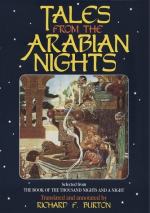[FN#34] Arab. “Aurat”: the word has been borrowed by the Hindostani jargon, and means a woman, a wife.
[FN#35] So in Al-Idrisi and Langles: the Bres. Edit. has “Al-Kalasitah”; and Al-Kazwini “Al-Salamit.” The latter notes in it a petrifying spring which Camoens (The Lus. x. 104), places in Sunda, i.e. Java-Minor of M. Polo. Some read Salabat-Timor, one of the Moluccas famed for sanders, cloves, cinnamon, etc. (Purchas ii. 1784.)
[FN#36] Evidently the hippopotamus (Pliny, viii. 25; ix. 3 and xxiii. 11). It can hardly be the Mulaccan Tapir, as shields are not made of the hide. Hole suggests the buffalo which found its way to Egypt from India via Persia; but this would not be a speciosum miraculum.
[FN#37] The ass-headed fish is from Pliny (ix. cap. 3): all those tales are founded upon the manatee (whose dorsal protuberance may have suggested the camel), the seal and the dugong or sea calf. I have noticed (Zanzibar i. 205) legends of ichthyological marvels current on the East African seaboard; and even the monsters of the Scottish waters are not all known: witness the mysterious “brigdie.” See Bochart De Cetis i. 7; and Purchas iii. 930.
[FN#38] The colossal tortoise is noticed by AElian (De Nat. Animal. xvi. 17), by Strabo (Lib. xv.), by Pliny (ix. 10) and Diodorus Siculus (iv. 1) who had heard of a tribe of Chelonophagi. AElian makes them 16 cubits long near Taprobane and serving as house-roofs; and others turn the shell into boats and coracles. A colossochelys was first found on the Scwalik Hills by Dr. Falconer and Major (afterwards Sir Proby) Cantley. In 1867 M. Emile Blanchard exhibited to the Academie des Sciences a monster crab from Japan 1.20 metres long (or 2.50 including legs); and other travellers have reported 4 metres. These crustaceae seem never to cease growing and attain great dimensions under favourable circumstances, i.e. when not troubled by man.
[FN#39] Lane suggests (iii. 97), and with some probability, that the “bird” was a nautilus; but the wild traditions concerning the barnacle-goose may perhaps have been the base of the fable. The albatross also was long supposed never to touch land. Possible the barnacle, like the barometz of Tartarean lamb, may be a survivor of the day when the animal and vegetable kingdoms had not yet branched off into different directions.
[FN#40] Arab. “Zahwah,” also meaning a luncheon. The five daily prayers made all Moslems take strict account of time, and their nomenclature of its division is extensive.




